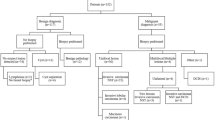Abstract
The purpose of the study was to determine prospectively the diagnostic value of a computed radiography (CR) system by comparing mammographic hard copy images with screen–film mammography (SFM). A series of 100 patients, who came for diagnostic investigation, underwent two-view SFM (Lorad M-IV Platinum) and digital mammography with a CR system (AGFA CR system). The images were obtained by double exposure, i.e. same view without removing compression of the corresponding breast. The CR images were processed with dedicated processing for mammography. Six radiologists read sets of SFM and CR images. The primary efficacy parameter was the overall diagnostic value. The secondary efficacy parameters were lesion conspicuity and lesion details (for masses and micro-calcifications), tissue visibility at chest wall and at skin line, axillary details, overall density and sharpness impression and the overall noise impression. These parameters were scored by a 7-point scoring system. “CR non-inferior to SFM” was concluded if the lower confidence interval bound exceeded 80%. The confidence interval for the overall diagnostic value was between 96.4% and 100%. Pooled analysis of the ten features for image quality comparison demonstrated for all but one feature (lesion details of the calcifications) CR non-inferiority to SFM.
Similar content being viewed by others
References
Yaffe MJ (2000) Digital mammography. In: Beutel J, Kundel HL, Van Metter RL (eds) Handbook of medical imaging, physics and psychophysics, vol. 1. SPIE, Bellingham, WA
James JJ (2004) The current status of digital mammography. Clin Radiol 59:1–10
Noel A, Thibault F (2004) Digital detectors for mammography: the technical challenges. Eur Radiol 14:1990–1998
American College of Radiology (ACR) (2004) Breast imaging reporting and data system (BI-RADS), 4th edn. American College of Radiology, Reston, Virginia
Vuylsteke P, Schoeters E (1994) Multiscale image contrast amplification (MUSICA). Proc SPIE 2167:551–560
Obenauer S, Luftner-Nagel S, von Heyden D, Munzel U, Baum F, Grabbe E (2002) Screen film vs full-field digital mammography: image quality, detectability and characterization of lesions. Eur Radiol 12:1697–1702
Cole EB, Pisano ED, Kistner EO (2003) Diagnostic accuracy of digital mammography in patients with dense breasts who underwent problem- solving mammography: effects of image processing and lesion type. Radiology 226:153–160
Pisano ED, Cole EB, Hemminger BM, Jaffe MJ (2000) Image processing algorithms for digital mammography: a pictorial essay. Radiographics 20:1479–1491
Lewin FM, Hendrick RE, D’Orsi CJ, Isaacs MF (2001) Comparison of full-field digital mammography with screen–film mammography for cancer detection: results of 4,945 paired examinations. Radiology 218:873–880
Skaane P, Young K, Skjennald A (2003) Population-based mammography screening: comparison of screen–film and full-field digital mammography with soft-copy reading—the Oslo I study. Radiology 229:877–884
Skaane P, Skjennald A (2004) Screen–film mammography versus full-field digital mammography with soft-copy reading: randomized trial in a population-based screening program—the Oslo II Study. Radiology 232:197–204
Fischer U, Baum F, Obenauer S, Luftner-Nagel S, van Heyden D, Vosshenrich R, Grabbe E (2002) Comparative study in patients with microcalcifications: full-field digital mammography vs screen–film mammography. Eur Radiol 12:2679–2683
Matzek WK, Pfarf G (2004) Digital storage phosphor mammography versus direct full field digital mammography for detection of breast cancer. Eur Radiol ECR report B-036, ECR 2004. Vol 14 Suppl 2, Feb 2004
Pisano ED, Gatsonis C, Hendrick E, Yaffe M, Baum JK, Acharyya S, Conant EF, Fajardo LL, Bassett L, D’Orsi C, Jong R, Rebner M (2005) Digital Mammographic Imaging Screening Trial (DMIST) Investigators Group. Diagnostic performance of digital versus film mammography for breast-cancer screening. N Engl J Med 353:1773–1783
Quam JP, Ackerman SJ (2003) Conspicuity and characterization of findings on computed radiography for mammography vs screen–film mammography: results from a prospective clinical trial. RSNA report no. 544
Author information
Authors and Affiliations
Corresponding author
Rights and permissions
About this article
Cite this article
Van Ongeval, C., Bosmans, H., Van Steen, A. et al. Evaluation of the diagnostic value of a computed radiography system by comparison of digital hard copy images with screen–film mammography: results of a prospective clinical trial. Eur Radiol 16, 1360–1366 (2006). https://doi.org/10.1007/s00330-005-0134-9
Received:
Revised:
Accepted:
Published:
Issue Date:
DOI: https://doi.org/10.1007/s00330-005-0134-9




